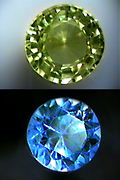![]()
Name:
Zircon

Chem:
ZrSiO3
Zirconium silicate
Crystal:
tetragonal (often short four-sided prisms with pyramidal ends)
Color:
brown, red, blue, yellow, green, clear, violet
Refrac. Index:
1.777 - 1.987
Birefraction:
0.039
Hardness:
6.5 - 7.5
Spec. Grav.:
4.6 - 4.71
Fracture:
conchoidal
Cleavage:
imperfect
Environment:
found in both igneous and metamorphic rocks
Association:
orthoclase, biotite, acmite
Locals:
| Australia | Fl., Maine, Co., N.J., USA | Sri Lanka | Urals | Canada |
Misc:
The name comes from the Persian "zargun", meaning "gold-colored". Is mined for its zirconium and hafnium content.
Gem info:
The majority of rough is brown or yellow-brown in color, and is often heat treated producing blue zircon of clear zircon. The blue, sometimes called "starlite" is popular in jewelry, although quite brittle, it has a high dispersion and produces brilliant cut stones with sparkle similar to diamond.
The yellow-red to red-brown variety is sometimes called "hyacinth". The rarest form is the green, and is the most demand by collectors. Yellow , brown, and clear stones are least valuable. Blue, clear red and bright green are the most prized. They are still well below the top colored gems, but in the same area as medium priced topaz, and beryls.
![]() blue
blue
![]() blue2
blue2
![]() yellow
yellow
![]() jewelry
jewelry